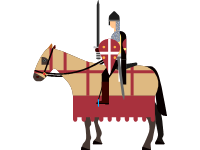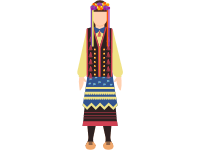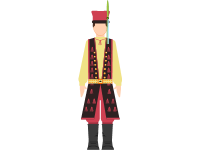| |
Amber is fossilized tree resin that has been appreciated for its color and natural beauty since Neolithic times. Much valued from antiquity to the present as a gemstone, amber is made into a variety of decorative objects. Amber is used in jewelry. It has also been used as a healing agent in folk medicine.
| |
The Centennial Hall, a landmark in the history of reinforced concrete architecture, was erected in 1911-1913 by the architect Max Berg as a multi-purpose recreational building, situated in the Exhibition Grounds. In form it is a symmetrical quatrefoil with a vast circular central space that can seat some 6,000 persons. The 23m-high dome is topped with a lantern in steel and glass. The Centennial Hall is a pioneering work of modern engineering and architecture, which exhibits an important interchange of influences in the early 20th century, becoming a key reference in the later development of reinforced concrete structures. The Centennial Hall in Wrocław, a milestone in the history of reinforced concrete architecture, was designed by the architect Max Berg and built in 1911-1913. The hall has a symmetrical quatrefoil ground plan with a huge circular central space covered by a ribbed dome topped with a lantern. It can accommodate up to 10,000 people.
The Centennial Hall is an outstanding example of early Modernism and the innovative use of reinforced concrete structures in the building industry. At the time of its construction, it was the largest ever reinforced concrete dome in the world. It played a significant role in the creation of a new technological solution of high aesthetic value, which became an important point of reference in the design of public spaces and in the further evolution of this technology. Drawing on historical forms, the building was a pioneering design responding to emerging social needs, including an assembly hall, an auditorium for theatre performances, an exhibition space and a sports venue. The building is a significant watershed in the history of Modern architecture.
The Exhibition Grounds, whose main feature the Centennial Hall, stands at the intersection of its principal axes, constitutes an integral spatial whole. They were designed jointly by Max Berg and Hans Poelzig. On the west side of the Centennial Hall there is a monumental square modelled on the ancient forum, which is preceded by the colonnade (built in 1925) of the main entrance. To the north of the square stands the Pavilion of the Historical and Artistic Exhibition, now known as the Four Domes Pavilion, which was built in 1912-1913 according to a design by Hans Poelzig. In the northern part of the Exhibition Grounds stands a concrete pergola enclosing a pond. It is separated from the Centennial Hall by a building housing a restaurant with an open terrace.
The design of the Exhibition Grounds combined new elements with the southern part of the 19th-century Szczytnicki Park, which was used as the setting for thematic garden exhibitions, such as the Japanese Garden, as well as for the temporary Exhibition of Cemetery Art, an extant reminder of which is an 18th-century wooden church relocated from Upper Silesia in 1912.
| |
Danziger Goldwasser, with Goldwasser as the registered tradename, is a strong (40% ABV) root and herbal liqueur which was produced from 1598 to 2009 in Danzig (Gdańsk). Production now takes place in Germany.
The most prominent characteristic of the drink is small flakes of 23 karat gold suspended in it. The beverage also includes herbs and spices such as cardamom, cloves, cinnamon, lavender, thyme, coriander and juniper, and has a syrupy texture.
| |
Until 2009 the Warmia Archdiocese conducted its historic preservation and inventory activities without having a museum of their own. The position of a diocese historic preservation officer and art clerk was established in 1957. The Sacred Art Commission was appointed in 1966. In 1994 the Art Department was upgraded to the Art Department of the Metropolitan Curia. By a decree of 5 October 2009 the Archbishop and Warmia Metropolitan Wojciech Ziemba founded the Museum of Warmia Archdiocese. The archdiocese historic preservation officer and the lecturer of the Warmia and Mazury University in Olsztyn, ks. dr [Rev. Phd] Jacek Wojtkowski became the director of the Museum.
In order to commemorate the 750th anniversary of the Warmia Cathedral Chapter the Museum prepared an exhibition Foundations of the Canons of the Warmia Cathedral Chapter – Patrimonium Warmiae historicum et artisticum in cooperation with the Nicolaus Copernicus Museum in Frombork. The exhibition presented the donations given by the canon priests to the Frombork cathedral and other parish churches. The elements of church equipment such as altars, paintings, sculptures, monstrances, incunables and stained glass windows were displayed there. A display on the search for the tomb of Nicolaus Copernicus was also prepared in 2010.
Since 2016 the Museum of the Historic Monument – Frombork Cathedral Complex continues the legacy of the Museum of Warmia Archdiocese.
| |
The Royal Castle in Warsaw is a royal residence that formerly served throughout the centuries as the official home of Polish monarchs. It is situated in Castle Square, at the entrance to the Warsaw Old Town. The personal offices of the king and the administrative offices of the royal court were located in the Castle from the 16th century until the final partition of Poland in 1795.
Initially, the fortified complex served as the residence of the Masovian dukes. In the early 1600s, it was designated to replace Wawel Castle in Kraków as the seat of the King, Parliament (Chamber of Deputies and Senate), and the Polish–Lithuanian Commonwealth. The medieval Gothic structure was remodelled into Italian mannerism by architects Matteo Castelli and Giovanni Battista Trevano. The Baroque easternmost wing was designed by Gaetano Chiaveri and completed in 1747.
The Royal Castle witnessed many notable events in Poland's history; the Constitution of 3 May 1791, first of its type in Europe and the world's second-oldest codified national constitution, was drafted here by the Four-Year Parliament. Following Poland's loss of sovereignty, the castle was redesigned for the needs of the Imperial Russian and later German administration during the course of World War I. Under the Second Polish Republic (1918–1939), it was the seat of the Polish head of state and president.
The Second World War brought complete destruction to the building; in September 1939 it was targeted and ignited by Luftwaffe fighter aircraft, and then detonated by the Nazis after the failed Warsaw Uprising in 1944. In 1965, the surviving wall fragments, cellars, the adjacent Copper-Roof Palace and the Kubicki Arcades were registered as historical monuments. Reconstruction was carried out in the years 1971–1984. In 1980, the Royal Castle and the Old Town became a UNESCO World Heritage Site. Today, it serves as a museum annually visited by over 500,000 people, and one of Warsaw's most recognizable landmarks.
| |
Christ the King is a statue of Jesus Christ in Świebodzin, western Poland, completed on 6 November 2010. The figure is 33 metres (108 ft) tall, the crown is 3 metres (9.8 ft) tall, and along with its mound, it reaches 52.5 metres (172 ft) overall. It took five years in total to construct and cost around $1.5 million to build, which was collected from donations of the 21,000 residents of the town. The project was conceived and led by Sylwester Zawadzki [pl], a retired Polish priest. It is the tallest statue of Jesus in the world. The statue was built on a 16.5 metres (54 ft) embankment of stones and rubble. Christ the King has a height of 33 metres (108 ft), symbolising a traditional belief that Jesus' age at his death was 33. The Crown of the temple is 3.5 metres (11 ft) in diameter and 2 metres (6.6 ft) in height, and the whole is gilded. It weighs 440 tons. The head alone is 4.5 metres (15 ft) tall and weighs 15 tons. Each hand is 6 metres (20 ft) in length and the distance between the ends of the fingers is 24 metres (79 ft). It is composed of concrete and fibreglass. It is 3 metres (9.8 ft) taller than the better known statue of Christ the Redeemer in Rio de Janeiro, standing at 30.1 metres (99 ft) tall without its pedestal.
| |
Wilanów Palace is a royal palace located in the Wilanów district, Warsaw. Wilanów Palace survived Poland's partitions and both World Wars, and so serves as a reminder of the culture of the Polish state as it was before the misfortunes of the 18th century.
It is one of Poland's most important monuments. The palace's museum, established in 1805, is a repository of the country's royal and artistic heritage and receives around 3 million visitors annually. The palace and park in Wilanów hosts cultural events and concerts, including Summer Royal Concerts in the Rose Garden and the International Summer Early Music Academy.
The palace, together with other elements of Warsaw Old Town, is one of Poland's official national Historic Monuments (Pomnik historii), as designated on 16th September 1994. Its listing is maintained by the National Heritage Board of Poland.
Since 2006, the palace has been a member of the international association of European Royal Residences.
|
|












